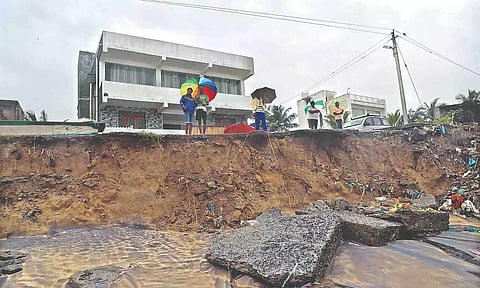

CHENNAI: A study conducted by researchers in Central University of Tamil Nadu has warned that 28% of the shoreline in Tamil Nadu falls under strong erosion category with an erosion rate of 1 metre per year. The study also highlighted that the southern part of the coastline was facing intensive erosion.
The research titled ‘Assessment of shoreline changes and associated erosion and accretion pattern in coastal watersheds of Tamil Nadu, India’ pointed out that the mean End Point Rate (EPR) and Net Shoreline Movement (NSM) of the State’s coastline is -0.26 metre/year and -8.03 metres/year respectively.
This suggests the overall TN shoreline is shifting towards landward. Nearly 41% of the shoreline has erosion.
During the study, researchers analysed the data pertaining to shoreline changes from 1988 to 2018, in addition to conducting field surveys at random locations between November 2020 and March 2021.
The minimum and maximum EPR along the coast are −19.01 metres/year (strong erosion) and 18.9 metres/year (strong accretion), respectively.
But, the overall mean EPR is −0.2655 metre/year, showing erosion-dominant coasts. About 28% of the shoreline falls under strong erosion (<−1.00 metres/year) and about 24% of the shoreline falls under strong accretion (>1.00 metre/year).
South Tamil Nadu at risk
“The coastal watersheds in the southern tip of Tamil Nadu’s coasts in Kanniyakumari district exhibit the highest erosion rates, followed by the region between the Vaigai and Tamirabarani river estuaries in Thoothukudi and Tirunelveli districts.
“The Cauvery delta watersheds, such as Kollidam and Arasalar in Nagapattinam and Cuddalore districts, also exhibit the highest erosion rates. The watersheds in Pudukkottai, Sivaganga and Thoothukudi have significant accretion,” the study identified.
All the watersheds of the southern coastal plains such as Puttan, Hanuma, Kodyar, and Nambiyar fall under the strong erosion risk. Besides these, Lower Vaippar, Vembar, and Gundar in the central coastal plains and Lower Palar, Kollidam, and Arasalarin northern coastal plains are also fall under strong erosion risk
The watersheds located between the Cauvery delta, Vaigai delta and Tamirabarani delta fall under a strong accretion category. In other words, the watersheds in the south Tamil Nadu has an erosion rate of -1.7 metre/year and northern watersheds has an erosion rate of -0.2 metre/year. Among the coastal towns, Marakkanam, Cuddalore, Karaikal, Nagapattinam, and Kanniyakumari are at higher risk of coastal erosion.
Reason for high erosion rate in Kanniyakumari district is, according to the study, is the projected rocky coasts that are highly exposed to marine forces and act as a ‘cape effect’ by impeding alongshore sediment flow and diverting it offshore.
Additionally, the drainage systems in the region are small and carry limited sediments to the coasts for accretion
In the northern part of the Tamil Nadu coast, the erosion is due to the rapid urbanisation and intensified human activities, which disturbs and diverts the natural processes. Also, because of engineering structures including protection structures, energy level of the waves has been intensified and eroded the unprotected shorelines of the surrounding villages.
Residents feel erosion
About 20% of the respondents, who were interviewed said that they live under a very high coastal erosion impact.
“Around 55% of respondents felt the high effects of coastal erosion, which covers virtually the whole coasts of the northern plains. They were asked about damages to the infrastructure by shoreline erosion in the recent past. Around 15% reported complete building damages and around 30% reported partial building damages due to shoreline erosion. Respondents in the coastal areas of Pudukottai and Ramanathapuram districts do not have much impact by shoreline erosion,” the report said.
The State Environment and Climate Change department has taken measures to launch the Tamil Nadu Coastal Restoration Mission to restore the coastal ecosystem by creating bio-shields. The project will also cover the Gulf of Mannar, where the impact of erosion is much higher.